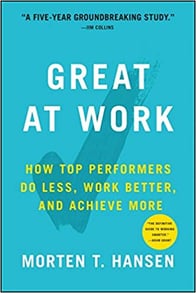 Have you ever wondered why you have to work long hours and others go home on time or early?
Have you ever wondered why you have to work long hours and others go home on time or early?
Have you ever wondered why some people are more productive than you?
Morten Hansen, co-author of Great by Choice with Jim Collins, did too!
It’s why he surveyed of over 5000 business people and workers to discover if some people are more productive, and what are the keys to doing so.
His results are in Great at Work: How Top Performers Do Less, Work Better, and Achieve More.
I’m in Denver today, for the ScaleUp Summit which starts tomorrow. One of the speakers is Morten Hansen.
HOW TO BE GREAT AT WORK
My next several blogs will feature presenters and topics from the Denver Scale Up Summit.
It’s appropriate to share one of the key findings from this Great by Choice co-author just ahead of his keynoting the Summit Tuesday.
In 2011,Hansen launched one of the most comprehensive research projects ever undertaken on individual performance at work.
Organizing potential “work smart” factors, into those scholars view as important to job performance, Hansen discovered seven “work smart” practices. 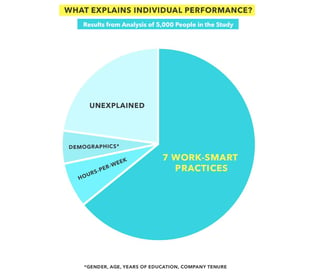
- When you work smart, you select a tiny set of priorities and make huge efforts in those chosen areas.
- You focus on creating value, not just reaching preset goals.
- You eschew mindless repetition in favor of better skills practice.
- You seek roles that match your passion with a strong sense of purpose.
- You shrewdly deploy influence tactics to gain the support of others .
- You cut back on wasteful team meetings, and make sure that the ones you do attend spark vigorous debate.
- You carefully pick which cross-unit projects to get involved in, and say no to less productive ones.
This is a pretty comprehensive list. The first four relate to mastering your own work, the last three concern mastering working with others. These seven work-smart practices explain differences in performance. They accounted for a 66 percent of the variation in performance among the 5,000 people in the study. (See chart)
In contrast, other factors tested (educational background, company tenure, age, gender, and hours worked) combined for only 10 percent of the differences in performance.
By improving these seven practices, you can boost your performance beyond relying on talent, luck, or the sheer number of hours worked.
The real key to your individual performance are these seven “work smarter” practices.
Hansen’s study found, the more a person adopted the seven practices in their work, the better they performed.
DO LESS THEN OBSESS
 Hansen believes these seven practices upend conventional thinking about how you should work.
Hansen believes these seven practices upend conventional thinking about how you should work.
Hansen thought, people who prioritized well would perform well.
They did, but they also did something else.
Once focused on a few priorities, they obsessed over those tasks to produce quality work. This extreme dedication to their priorities created extraordinary results.
Top performers did less and more: less volume of activities, more concentrated effort.
Conventional thinking urges you to choose a few tasks to prioritize. This choice is only half of the equation—you also need to obsess. These findings led Hansen and his team to reformulate the “work scope” practice and call it “do less, then obsess.”
Picking a few priorities is only half the equation. The other half is the harsh requirement that you must obsess over your chosen area of focus to excel.
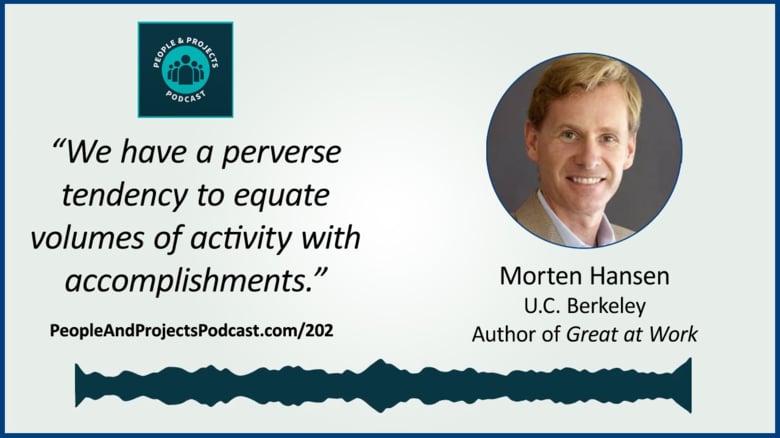 The term “focus” consists of two activities: choosing a few priorities, and then dedicating your efforts toward excelling at them. Many people prioritize a few items at work, but they don’t obsess—they simply do less. That’s a mistake.
The term “focus” consists of two activities: choosing a few priorities, and then dedicating your efforts toward excelling at them. Many people prioritize a few items at work, but they don’t obsess—they simply do less. That’s a mistake.
People who were average at other practices but mastered “do less, then obsess” would place 25 percentage points higher in performance rankings than those who didn’t embrace this practice.
The “Do less, then obsess” practice affects performance more than any other practice in this book.
In a future blog will share stories exemplifying this “Do less, then obsess” practice, including how Great by Choice’s 20 Mile March shares this practice. Ronald Amundsen fanatic discipline wasn’t the only reason his team finished first to reach the South Pole.
The Positive Effect of the Seven Practices Combined on Individual Performance
The seven “work smarter” practices didn’t just improve performance. They also improved people’s well-being at work. The people in Hansen’s study who worked smarter experienced better work-life balance, higher job satisfaction, and less burnout.
Being great at work means performing in your job, infusing your work with passion and a strong sense of purpose, and living well, too.
Growth demands Strategic Discipline.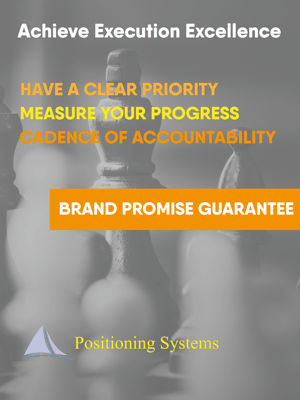
Positioning Systems is fanatically driven to improve your business and your teams execution at work. 3 Strategic Disciplines: Priority, Metrics and Meeting Rhythms help your business dramatically improve your forecasting, and alignment. It empowers your team to achieve accelerated growth.
The Execution Decision result in Profit. Positioning Systems helps you achieve Execution Excellence.
Positioning Systems helps your business achieve these outcomes on the Four most Important Decisions your business faces:
|
DECISION |
RESULT/OUTCOME |
|
PEOPLE |
|
|
STRATEGY |
|
|
EXECUTION |
|
|
CASH |
|
Positioning Systems helps mid-sized ($5M - $250M) business Scale-UP. We align your business to focus on Your One Thing! To achieve growth, you need to evolve in today’s rapidly changing economic environment. Have you been avoiding a conversation on how you can successfully grow your business? Contact dwick@positioningsystems.com to Scale Up your business! Take our Four Decisions Needs Assessment to discover how your business measures against other Scaled Up companies. We’ll contact you.
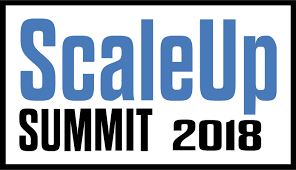 Next Blog – Denver ScaleUp Summit
Next Blog – Denver ScaleUp Summit
Morten Hansen will keynote tomorrow’s Denver Scale Up Summit. This is a working summit for me. Working with one of my customers while here on improving their teamwork through the Five Dysfunctions of a Team exercise means I’m unable to provide updates for my blogs on the Summit speakers. Look for a overview of what I learned and a specific speaker from the Summit next blog.






.jpeg?width=150&height=135&name=Hand%20with%20marker%20writing%20the%20question%20Whats%20Next_%20(1).jpeg)

